
Antrim 1844 Country House Hotel is a historic inn located in the heart of Taneytown, Carroll County, Maryland, United States. The Mansion is a 2+1⁄2-story Greek Revival style brick masonry house constructed in 1844. The property retains many of its outbuildings and is operated as a hotel and restaurant. In 2022 the hotel itself is currently a member of Historic Hotels of America, an official program of the National Trust for Historic Preservation.

Montrose is a historic slave plantation located at Clarksville, Howard County, Maryland, United States. It was built in 1844 by Dr. William H. Hardey, prominent physician and secessionist in the American Civil War. One of Dr. Hardey's six children married John Randall, brother of James Ryder Randall, the author of "Maryland, My Maryland!" The house is basically a five-bay-wide, two-bay-deep, and 2+1⁄2-story stone structure with two dormers set into the gable roof on its south elevation and wide brick chimneys set into its east and west walls. A shingled 1+1⁄2-story cottage lies north of Montrose with barns and outbuildings lying northwest of them both.

Cedar Hill is a historic home located on 75 acres (300,000 m2) at Barstow, Calvert County, Maryland, United States. It is one of the few remaining cruciform dwelling houses existing in Maryland, built in the 18th century that is typical of 17th-century architecture. It is a 1+1⁄2-story house with a 2-story porch tower, built of brick laid in Flemish bond. It is now operated as a private farm and home to a variety of livestock such as cattle, swine and chickens.
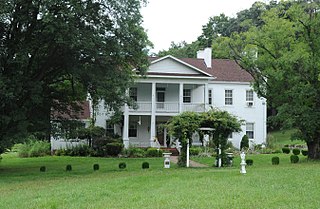
Phoenix Mill Farm, historically known as Mill Run Farm, is a historic home located in Dickens, Allegany County, Maryland, United States. It is a 2+1⁄2-story Flemish bond brick structure showing Greek Revival style influences built about 1845. It has a gable roof and double flush chimneys. On the property is the site of Smouse Mill. The home was erected for John Jacob Smouse, who operated the mill.
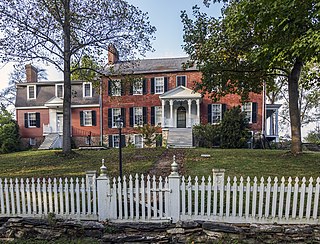
Hopewell is a set of historic homes and farm complexes located at Union Bridge, Carroll County, Maryland, United States. It consists of four related groupings of 19th century farm buildings. The Hopewell complex consists of two historic farms: Hopewell and the smaller F.R. Shriner Farm.

St. Francis Xavier Church, or Old Bohemia, is a historic Roman Catholic church located at Warwick, Cecil County, Maryland, United States. It is located on what was once the Jesuit estate known as Bohemia Manor.

Olney, originally patented as Prospect, is a historic home and farm complex located at Joppa, Harford County, Maryland. It is a 264-acre (1.07 km2) working pony farm with a collection of 15 structures ranging in style, use, and elegance. The main building on the property is a 2+1⁄2-story brick house dating to 1810, generally called "the mansion." The house was evolved into a museum of Maryland architecture, with salvaged features from demolished buildings in Baltimore and Philadelphia. These include paneling from the Isaac Van Bibber house in Fells Point, Baltimore dating to 1815; the marble Ionic portico from William Small's Baltimore Athenaeum from 1830; and a marble bas-relief plaque designed by Pierre L'Enfant for Robert Morris's great 1795 house in Philadelphia. Also on the property is an early-18th-century, 2+1⁄2-story stone dwelling and a variety of still-functioning farm structures that in themselves range in style from simple stone stables and frame hay barns to an unusual two-story brick blacksmith's shop. In addition, the 1914 Union Chapel School, was moved onto the property in 1980 and re-outfitted as St. Alban's Anglican Church. The property was developed by J. Alexis Shriver (1872–1951), a man prominent in local and state historical and agricultural matters who lived at Olney from 1890 until his death.

Avalon is a historic home located near New Windsor, Carroll County, Maryland. It is a 1+1⁄2-story, early-19th-century brick house constructed c. 1814, and reflecting the influence of Neoclassical architecture.

Avondale is a historic home located at Westminster, Carroll County, Maryland. It is a Georgian style, 2+1⁄2-story brick house, measuring approximately 45 feet long by 18+1⁄2 feet deep, built about 1796. The house has a two-story wing measuring approximately 49 feet long by 13 feet deep. It features a Palladian window centered on the pavilion directly over the entrance door.

The Englar-Schweigart-Rinehart Farm is a historic home and farm complex located at Westminster, Carroll County, Maryland, United States. It consists of a brick house, a brick smokehouse, a stone springhouse, a frame bank barn, and a frame poultry house. The house is a two-story, five-by-two-bay Flemish bond brick structure painted white, and set on a rubble stone foundation. The house was constructed in 1809 or 1810. The farm is significant for its illustration of how German-Swiss immigrants to Maryland became acculturated to the dominant English culture.

Farm Content is a historic home located at Westminster, Carroll County, Maryland, United States. It is a two-story brick structure, five bays wide at the principal façade and built about 1795. It is one of the finest examples of rural Federal architecture in Carroll County, and as the home of David Shriver, progenitor of the Shriver family in Maryland.
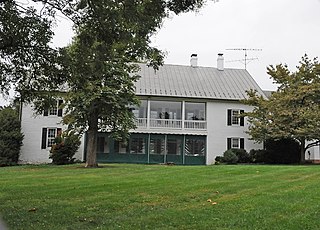
Friendship Valley Farm is a historic home and farm complex located at Westminster, Carroll County, Maryland, United States. It was established in the late 18th century. About that time a 2+1⁄2-story T-shaped main house was built of brick on a stone foundation. It was later expanded to its current "H" shape. One of the small log cabins still standing near the house was once a slave cabin. It was later used as a smoke house. Also on the property is a large brick wash-house and summer kitchen built in 1860, with a bell tower on the roof.

Hard Lodging is a historic home located at Union Bridge, Carroll County, Maryland, United States. It is built on a small cliff overlooking the site where its first owner, Solomon Shepherd, had a mill that is no longer standing. The house was built in three stages: the middle section, a 2+1⁄2-story brick structure, was probably built first; the main section of the house is attached to the west and is a Federal-style, three-by-two-bay, 2+1⁄2-story house with an interior gable-end chimney. Hard Lodging is currently a private residence and is no longer owned by the Historical Society. The home is an example of Pennsylvania German architecture.

Mt. Pleasant, also known as the Clemson Family Farm, is a historic home located at Union Bridge, Carroll County, Maryland, United States. It is a five-bay by two-bay, 2+1⁄2-story brick structure with a gable roof and built about 1815. Also on the property is a brick wash house, a hewn mortised-and-tenoned-and-pegged timber-braced frame wagon shed flanked by corn cribs, and various other sheds and outbuildings. It was the home farm of the Farquhar family, prominent Quakers of Scotch-Irish descent who were primarily responsible for the establishment of the Pipe Creek Settlement.

The Stoner–Saum Farm is a historic home and farm complex located at Union Bridge, Carroll County, Maryland, United States. The complex consists of a brick house, a frame bank barn, a brick smokehouse, a stone ice house and summer kitchen, a stone wagon shed, and several other frame farm outbuildings. The house is a two-story, five-bay by two-bay structure with a rubble stone foundation.
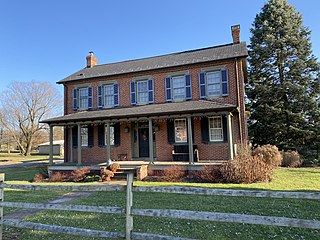
The Winemiller Family Farm is a historic home and farm complex located at Taneytown, Carroll County, Maryland, United States. The complex consists of a large two-story brick house built about 1865, a frame bank barn, and several outbuildings. It is a representative example of a type of family farm complex that characterized rural agricultural Carroll County from about 1850 through the early 20th century.
Keefer–Brubaker Farm, also known as the Oscar Fogle Farm, is a historic home and farm complex located at Taneytown, Carroll County, Maryland. It consists of a two-story six-by-two-bay log-and-frame house which is partially encased in brick and rests on a rubble stone foundation Also on the property is a frame summer kitchen, a combination smokehouse/dry house, a frame springhouse, a shop building, a bank barn, a dairy, a hog pen, a tool shed, poultry house, and several more recent buildings. It is a representative example of a family farm complex which spans the period from the late 18th century to the mid 20th century.
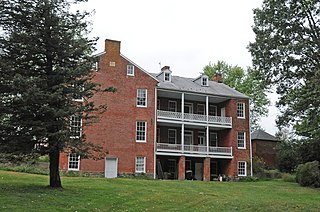
The John Orendorff Farm is a historic home and farm complex located at Westminster, Carroll County, Maryland, United States. The complex consists of a brick house, a brick privy, a brick smokehouse, a frame barn, a frame hog pen, a frame wagon shed, two poultry houses, and a feed house. The house is a five-by-two-bay brick structure, built in 1861 in the Italianate style. It has a 2+1⁄2-story, six-by-two-bay brick ell on the north side.

Carroll County Almshouse and Farm, also known as the Carroll County Farm Museum, is a historic farm complex located at Westminster, Carroll County, Maryland. It consists of a complex of 15 buildings including the main house and dependencies. The 30-room brick main house was originally designed and constructed for use as the county almshouse. It is a long, three-story, rectangular structure, nine bays wide at the first- and second-floor levels of both front and rear façades. It features a simple frame cupola sheltering a farm bell. A separate two-story brick building with 14 rooms houses the original summer kitchen, wash room, and baking room, and may have once housed farm and domestic help. Also on the property is a brick, one-story dairy with a pyramidal roof dominated by a pointed finial of exaggerated height with Victorian Gothic "icing" decorating the eaves; a large frame and dressed stone bank barn; and a blacksmith's shop, spring house, smokehouse, ice house, and numerous other sheds and dependencies all used as a part of the working farm museum activities. The original Carroll County Almshouse was founded in 1852 and the Farm Museum was established in 1965.
The John Embert Farm is a historic home located at Millington, Queen Anne's County, Maryland, United States. It is a 1+1⁄2-story Flemish bond brick house with a two-bay facade. The building is an exceedingly rare and almost pristine example of a small-scale Tidewater house.






















